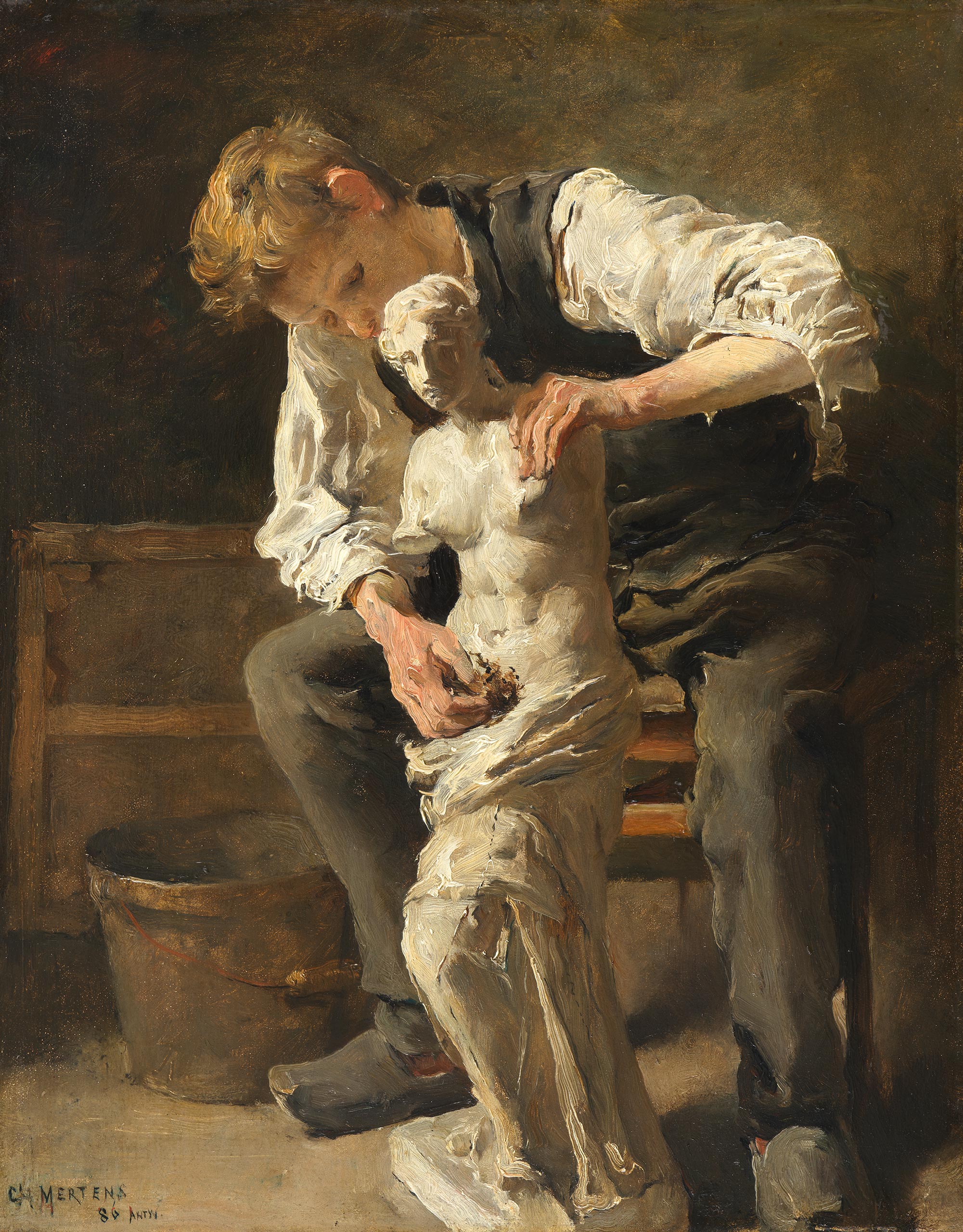
Mertens
Charles Joseph
Antwerp 1865 — Calverley, England 1919
In the Studio
Oil on mahogany panel.
Signed, located and dated Ch. Mertens/ 86 Antw(erpen) lower left.
22 x 17 cm (8 10/16 x 6 11/16 in.)
A painting turned around and placed casually against the back wall indicates that we are in an artist’s studio. A young sculptor sitting on a chair is either finishing or cleaning a plaster cast of the Venus de Milo. The style of this early work is quick and lively, the lighting intelligently placed; it’s a snapshot of life in the workshops.
Son of a goldsmith and nephew to a composer and conductor, Mertens studied at the Royal Academy of Fine Arts in Antwerp from 1876 to 1885, notably under Charles Verlat (1824-1890), a painter of genre and Orientalist scenes who also briefly taught Vincent Van Gogh. In 1883, Mertens became a member of the Union artistique des jeunes (Artistic Union of Young People), better known as the Als Ik Kan (If I May) group, taken from the name of their motto and created to enable young artists to exhibit their work independent of official circuits. It also counted the painter, architect and theorist of the Jugensdstil, Henry Van de Velde (1863-1957) among its members. In 1886, the date of this work, Mertens, who was not even twenty, was appointed professor at the Académie des Beaux-arts as proof of his maturity. That same year, he was one of the founding members of the association De XIII (Circle of the XIII), a secessionist group modelled on the Brussels XX, whose aim was to organise exhibitions outside the traditional salons.
Until the early 1890s, Mertens enjoyed real success with his small genre scenes and city views executed in a smooth, technical style – the style of works painted by another of his masters, Henri de Braekeleer. He subsequently moved towards painting more atmosphere and light, employing small brushstrokes under the influence of the Impressionists. He painted many scenes revolving around the lives of fishermen, the activities of river navigation (particularly in Zeeland) and portraits of fishermen as in Couple from Zeeland (Royal Museums of Fine Arts, Antwerp), a simple, dignified modelling of a fisherman and his wife painted in melancholy pastel tones. In Brussels, The Royal Museums of Fine Arts of Belgium owns two fine paintings, The Zeeland Family and Portrait of Antwerp Painter Jules Lambeaux in his Studio, both 1885. His works leaned towards symbolism. In 1894, he became a corresponding member of the Munich Secession. In 1898 and 1901, he exhibited at the Libre Esthétique in Brussels and in 1907, he was commissioned to decorate the ceiling of the Antwerp Opera House. Mertens was a skilled draughtsman and a prolific engraver too, and his portraits made “with a Holbein-like hand1” were much appreciated by his contemporaries.
Men at work in their studios were among Mertens’ favourite themes. He portrayed painter friends seated in front of their easels, among others, Jules Lambeaux and Pieter van Havermaet, but was also interested in the smaller trades like shoemakers, metal engravers, tailors, in painting as in print. Perhaps in this painting, made as a sketch, he depicts one of his young classmates studying at the Royal Academy of Fine Arts in Antwerp, from which he had graduated the previous year. The sculpture also appears in an interior scene painted in 1887 depicting a young woman sitting in the corner of a studio looking at an engraving, A Close Look2.
- Camille Lemonnier, cited in Gérald Schur, Les petits maîtres de la peinture 1892-1920, Paris 1895, Mertens article.
- Christie’s Amsterdam, 2/05/1990, Lot 121.

